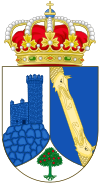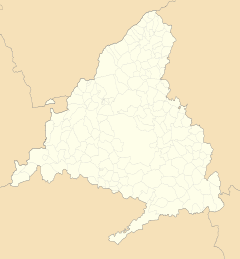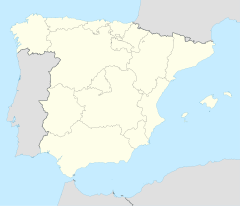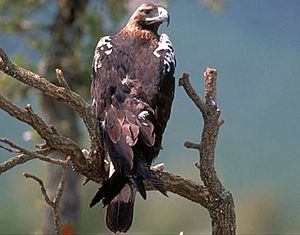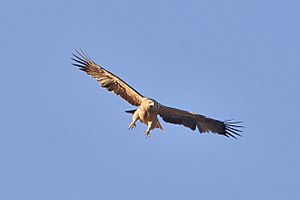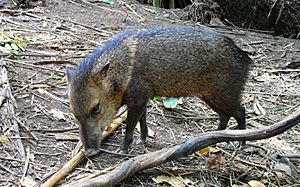Torrelodones facts for kids
Quick facts for kids
Torrelodones
|
|||
|---|---|---|---|
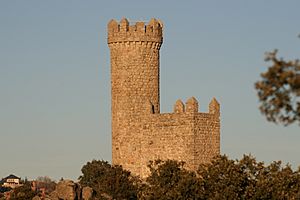
Watchtower of Torrelodones, gives the name to the municipality
|
|||
|
|||
| Nickname(s):
Torre
|
|||
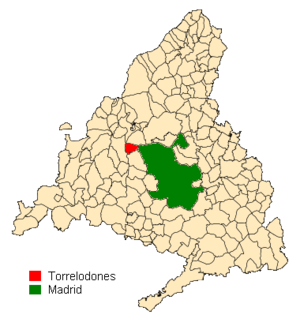
Location in the Community of Madrid, Spain
|
|||
| Country | Spain | ||
| Autonomous community | Community of Madrid | ||
| Province | Madrid | ||
| Comarcas | Madrid metropolitan area Comarca agrícola de Guadarrama |
||
| Administrative Divisions | 3 | ||
| Founded | c. VII century | ||
| Population nuclei | Pueblo, Colonia, Los Peñascales | ||
| Area | |||
| • Total | 21.95 km2 (8.47 sq mi) | ||
| Elevation | 845 m (2,772 ft) | ||
| Highest elevation | 1,011 m (3,317 ft) | ||
| Lowest elevation | 675 m (2,215 ft) | ||
| Population
(2021)
|
|||
| • Total | 24,122 | ||
| • Density | 1,053.67/km2 (2,729.0/sq mi) | ||
| Time zone | UTC+01:00 (CET) | ||
| • Summer (DST) | UTC+02:00 (CEST) | ||
| Postal code |
28250
|
||
| Area codes | +34 (Spain) + 91 (Madrid) | ||
Torrelodones is a town in the northwest of the Community of Madrid, Spain. It is about 29 kilometers (18 miles) northwest of the city of Madrid. Its location is special, sitting between the Sierra de Guadarrama mountains and the big city of Madrid. This means it connects to both the farming areas of Guadarrama and the busy Madrid metropolitan area.
The town is about 845 meters (2,772 feet) above sea level. In 2014, about 22,838 people lived here, spread across seven smaller areas. People in Torrelodones generally earn good incomes, among the highest in the Community of Madrid. The main jobs are in services, hotels, and construction.
Torrelodones is often split into two parts: "Torrelodones town" (where the Town Hall is) and "Torrelodones colony" (where you find schools, homes, and small shops). The town has interesting old buildings and beautiful nature. It's part of two special tourist routes in Madrid. One is the Imperial Route, which follows a path King Philip II used in the 1500s. The other is the Route through Castles, Fortresses, and Watchtowers, linked by the famous Watchtower of Torrelodones.
Torrelodones shares borders with Hoyo de Manzanares to the north, Las Rozas de Madrid to the south, Galapagar to the west, and Madrid (through El Monte de El Pardo) to the east.
The name "Torrelodones" comes from two things. "Torre" means "tower," referring to the old Muslim watchtower. This tower was used during the time of Al-Andalus to protect the area from Christian attacks. "Lodones" comes from "Lodon," which is a type of hackberry tree that used to grow a lot in this area.
Contents
Discovering Torrelodones' Symbols
The town's special badge, or coat of arms, was officially approved in 1979. It shows a tower on a silver background, a gold band with dragon heads, and a hackberry tree with black fruits. On top of the shield is a royal crown.
The town's flag was approved in 1992. It's a rectangular flag, divided diagonally into two equal parts. The top left is blue, and the bottom right is yellow. In the very middle of the flag, you'll see the town's coat of arms.
Exploring Torrelodones' Geography
Where is Torrelodones Located?
Torrelodones is surrounded by other towns and natural areas:
- To the north: Hoyo de Manzanares, near the Parque Regional de la Cuenca Alta del Manzanares.
- To the south: Las Rozas de Madrid, including areas like Las Matas and Los Peñascales.
- To the west: Galapagar, with the Guadarrama River forming part of the border.
- To the east: The city of Madrid, specifically through the Monte de El Pardo forest.
How is Torrelodones Populated?
Torrelodones has seven main areas where people live. These are officially recognized towns:
- Torrelodones (center)
- Los Robles
- Los Peñascales
- Los Bomberos
- La Estación
- La Berzosilla
- El Gasco
There are also other smaller neighborhoods, but they are not officially recognized as separate towns.
| Towns | Coordinates | Population (2009) | |||
|---|---|---|---|---|---|
| Torrelodones (center) | 40°34′35″N 3°55′46″O | 8272 | |||
| Los Robles | 40°35′7″N 3°55′14″O | 1292 | |||
| Los Peñascales | 40°34′19″N 3°53′52″O | 4218 | |||
| Los Bomberos | 40°34′12″N 3°55′35″O | 1262 | |||
| La Estación | 40°34′36″N 3°56′58″O | 5336 | |||
| La Berzosilla | 40°35′12″N 3°56′51″O | 528 | |||
| El Gasco | 40°34′3″N 3°56′44″O | 323 | Total | 21231 | |
Town vs. Colony: Two Parts of Torrelodones
Torrelodones is divided into two main parts: Torrelodones-pueblo (the town) and Torrelodones-colonia (the colony).
The "Torrelodones-pueblo" is the older, historical part. It grew up around a street called Calle Real (Royal Street) a long time ago. Over the years, more buildings, businesses, and small shops were built here.
The "Torrelodones-colonia" started to grow in the late 1800s around the railway station. It has many small townhouses, apartments, and villas. This area is still developing today.
Both the town and the colony are important centers for social life, government, and business in Torrelodones. Most of the people (about 64%) live in these two areas, and most of the shops, industries, and services are found here.
Torrelodones' Climate
Torrelodones has a Mediterranean climate, but with some features of a continental climate. This means it has cold winters. Temperatures can drop below 5 °C (41 °F), and it often freezes at night. Sometimes, it even snows.
Summers are warm, usually around 25 °C (77 °F). However, temperatures can sometimes go above 35 °C (95 °F). The town gets more than 400mm (15.7 inches) of rain each year.
| Torrelodones' average climatic parameters in the period 1961-2003 | |||||||||||||
|---|---|---|---|---|---|---|---|---|---|---|---|---|---|
| Month | Jan | Feb | Mar | Apr | May | Jun | Jul | Aug | Sep | Oct | Nov | Dic | Annual |
| Total rainfall (mm) | 57.8 | 46.7 | 34.8 | 51.1 | 51.8 | 30.1 | 10.8 | 10.7 | 33.6 | 56.0 | 80.1 | 60.0 | 523.6 |
Plants and Animals of Torrelodones
What Plants Grow Here?
Torrelodones has many plants typical of the Mediterranean region in Spain. The most common trees are Holm oaks. You can also find junipers, oaks, and pine trees. Some pine forests have grown naturally over time.
What Animals Live Here?
Torrelodones is home to many different animals. It's located near two protected natural areas: Sierra de Hoyo and Monte del Pardo.
You can find birds, mammals, reptiles, amphibians, and many small invertebrates here. Many of these animals are listed as endangered or protected in national and regional lists.
Birds You Might See
The Spanish imperial eagle (Aquila adalberti) is a very important bird in this area.
Other birds include:
- The Hawfinch (Coccothraustes coccothraustes)
- The Garden warbler (Sylvia borin)
- The Common whitethroat (Sylvia communis)
- The Western Orphean warbler (Sylvia hortensis)
- The Spotted flycatcher (Muscicapa striata)
- The Eurasian golden oriole (Oriolus oriolus)
- The Western black-eared wheatear (Oenanthe hispanica)
- The Eurasian wren (Troglodytes troglodytes)
- The European green woodpecker (Picus viridis)
- The Little owl (Athene noctua)
- The Eurasian scops owl (Otus scops)
- The Hoopoe (Upupa epops)
- The Great tit (Parus major)
- The Southern grey shrike (Lanius meridionalis)
- The Woodchat shrike (Lanius senator)
- The European bee-eater (Merops apiaster)
- The Spotless starling (Sturnus unicolor)
- The Iberian magpie (Cyanopica cooki)
- The European robin (Erithacus rubecula)
- The Common nightingale (Luscinia megarhynchos)
- The Common blackbird (Turdus merula)
- The European serin (Serinus serinus)
- The European greenfinch (Carduelis chloris)
- The Common linnet (Carduelis cannabina)
- And various thrushes (Turdus spp.).
Some birds are also hunted, like the Red-legged partridge (Alectoris rufa), the Common quail (Coturnix coturnix), the European turtle dove (Streptopelia turtur), and the Common wood pigeon (Columba palumbus).
Raptor birds, or birds of prey, include the Common buzzard (Buteo buteo) and the Black-winged kite (Elanus caeruleus).
Mammals You Might See
In Torrelodones, especially in protected areas, you can find mammals like:
- The Red squirrel (Sciurus vulgaris)
- The European hedgehog (Erinaceus europaeus)
- The European rabbit (Oryctolagus cuniculus)
- The Granada hare (Lepus granatensis)
- The Least weasel (Mustela nivalis)
- The Common genet (Genetta genetta)
- The Sierra Nevada red fox (Vulpes vulpes)
- The Wild boar (Sus scrofa)
- The Wood mouse (Apodemus sylvaticus)
- The House mouse (Mus domesticus)
- The Garden dormouse (Eliomys quercinus)
- The Greater white-toothed shrew (Crocidura russula)
- The Spanish mole (Talpa occidentalis)
- And the Cabrera's vole (Microtus cabrerae).
Reptiles and Amphibians You Might See
Torrelodones is home to reptiles such as:
- The Large psammodromus (Psammodromus algirus)
- The Spanish Psammodromus (Psammodromus hispanicus)
- The Podarcis hispanicus (Iberian wall lizard)
- The Ocellated lizard (Lacerta lepida)
- The Tarentola mauritanica (Moorish gecko)
- The Amphisbaenia (worm lizard)
- The Grass snake (Natrix natrix)
- The Natrix maura (viperine snake)
- And the Ladder snake (Elaphe scalaris).
Among the amphibians are:
- The Natterjack toad (Bufo calamita)
- The common spadefoot toad (Pelobates cultipes)
- The Iberian midwife toad (Alytes cisternasii)
- The Iberian painted frog (Discoglossus galganoi)
- And the Iberian ribbed newt (Pleurodeles waltl).
Invertebrates You Might See
There are countless species of invertebrates (animals without backbones) in Torrelodones. Two types of butterflies that are endangered are:
- The Zerynthia rumina (Spanish festoon)
- And the Marsh fritillary (Euphydryas aurinia).
Images for kids
See also
 In Spanish: Torrelodones para niños
In Spanish: Torrelodones para niños



